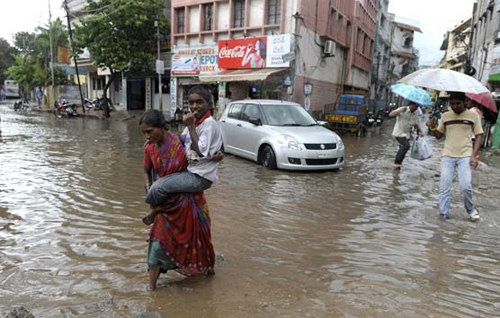 Bhubaneswar, Oct 11: Cyclone Phailin with a wind speed of 220km per hour is turning into a super cyclone before making landfall on Saturday evening near Gopalpur in Odisha where the government has galvanized its machinery to deal with its impact and is evacuating thousands of people from low-lying areas.
Bhubaneswar, Oct 11: Cyclone Phailin with a wind speed of 220km per hour is turning into a super cyclone before making landfall on Saturday evening near Gopalpur in Odisha where the government has galvanized its machinery to deal with its impact and is evacuating thousands of people from low-lying areas.
"The US Navy has also forecast that the wind speed will be above 240kmph. Therefore, the cyclone is not less than any super cyclone for us," special relief commissioner P K Mohapatra said.
He said that though the IMD on Friday indicated that the wind speed would be limited to 185kmph, it was now forecasting it at 220kmph.
Mohapatra said the IMD had declared the 1999 calamity as a super cyclone as the wind speed had crossed 220kmph.
"This time around, the wind speed is not much different than the previous super cyclone," he said.
Squalls with a wind speed of 45-55kmph to 65kmph have already started along Odisha coast since morning.
"It would increase in intensity with gale wind speeds reaching 210-220kmph along and off south Odisha at the time of landfall," the IMD said in a bulletin categorised as an Orange Message.
It would make landfall near Gopalpur in Ganjam district on Saturday evening after crossing an area between Paradip in Odisha and Kalingapatnam in Andhra Pradesh.
The IMD said the cyclone over east central Bay of Bengal remained stationary and lay 520km south-southeast of Paradip and 530km southeast of Gopalpur.
The IMD forecast a storm surge of 2.5 metre to 3.0 metre in Ganjam, Khurda, Puri and Jagatsinghpur districts.
A storm surge is a rise of the sea as a result of atmospheric pressure changes and winds associated with a storm.
Local Cautionary (LC-III) has been hoisted in all the ports in the state.The Navy, Airforce, NDRF, ODRF were ready for relief and rescue operation as soon as the cyclone hit the coast, Mohapatra said.
A worried state government held meetings and evaluated the changed circumstances.
"At least 28 teams of the National Disaster Response Forces are at the disposal of the Odisha government for evacuation and relief operations," a senior official said after one such meeting.
So far eight teams of NDRF, reaching having 20 personnel, have been deployed in Puri district, the official said.
Revenue and Disaster Management Minister S N Patro said district collectors have been told to complete evacuation of people by this evening.
"We do not want to take any chance," Patro said, adding that shelters were ready.
Appealing to the people not to panic, chief minister Naveen Patnaik asked them to cooperate with the government in relief and rescue operations.
Earlier:
Cyclone Phailin: Antony asks armed forces to be ready
New Delhi Oct 11: Defence Minister A K Antony today asked the armed forces to be ready to move in to Odisha and Andhra Pradesh in view of the impending severe cyclonic storm Phailin.
Two IAF IL-76 aircraft have already airlifted NDRF teams and equipment to Bhubneshwar.
IAF assets have been kept on stand by at various bases including – Raipur, Nagpur, Jagdalpur, Barrackpore, Ranchi and Gwalior.
It has also kept two C130J aircraft, 18 helicopters, 2 AN-32s aircraft on a standby to move at a short notice besides asking its Eastern Air Command to coordinate relief operation with the task force positioned at Barrackpore.
The intensity of cyclonic storm Phailin is likely to increase as it has crossed the wind speed of 205-215 kmph in the early hours today, the MET department said.
The storm is still 520 km south-southeast of Paradip, 530 km southeast of Gopalpur, and 530km east-southeast of Kalingapatnam.
It would move northwestwards and cross north Andhra Pradesh and Odisha coast between Kalingapatnam and Paradip, close to Gopalpur (Odisha) by evening of 12th October as a "very severe cyclonic storm" with a maximum sustained wind speed of 205-215 kmph. The tide height too is expected to be around 2 meters to 2.5 meters.
"The intensity of the storm has increased in the last few hours. Although it is a very severe cyclonic storm, it still cannot be termed as a super cyclone. We have keeping a close watch on it" said a senior MET department official.
Earlier:
Phailin gains strength, wind speed to reach 215 kmph: IMD Bhubaneswar, Oct 11: The severe cyclonic storm Phailin over east central Bay of Bengal today further intensified and is all set to make a landfall close to Gopalpur in Odisha at a wind speed of at least 205 kmph tomorrow.
Bhubaneswar, Oct 11: The severe cyclonic storm Phailin over east central Bay of Bengal today further intensified and is all set to make a landfall close to Gopalpur in Odisha at a wind speed of at least 205 kmph tomorrow.
"The very severe cyclonic storm, PHAILIN over east central Bay of Bengal moved west-northwestwards with a speed of 15 kmph and lay centred about 520km south-southeast of Paradip, 530 from Gopalpur and 530km east-southeast of Kalingapatnam," the IMD said in its latest bulletin.
"It would move northwestwards and cross north Andhra Pradesh and Odisha coast between Kalingapatnam and Paradip, close to Gopalpur (Odisha) by the evening of October 12," the IMD said.
IMD, which till last night expected that the wind speed would remain limited within 185 kmph during landfall on Saturday, said in its latest bulletin that Phailin would hit with increased intensity with a maximum sustained speed of 205-215 kmph.
Similarly, though IMD forecast a storm surge of 1.5 meter to 2 meter in Ganjam, Khurda, Puri and Jagatsinghpur districts in the coast yesterday, today it said the storm surge height will be around 2 meter to 2.5 meter above astronomical tide. This would inundate low lying areas of Ganjam, Khurda, Puri and Jagatsinghpur in Odisha.
Squally winds speed reaching 45-55 kmph gusting to 65 kmph have already started along Odisha coast this morning under the influence of Phailin. "It would increase in intensity with gale wind speed reaching 205-215 kmph along and off coastal districts of south Odisha at the time of landfall," the IMD said.
Meanwhile, a worried state government held several meetings and took stock of the situation in the changed circumstances. The state government has already asked the district authorities to start evacuation of people living in low lying areas close to the sea.
"We have ordered that nobody should be allowed to stay in thatched and weak houses," Special Relief Commissioner (SRC) P K Mohapatra said.
The personnel of of Odisha State Disaster Rapid Action Force (ODRAF) and fire men have already been deployed.





Comments
Add new comment